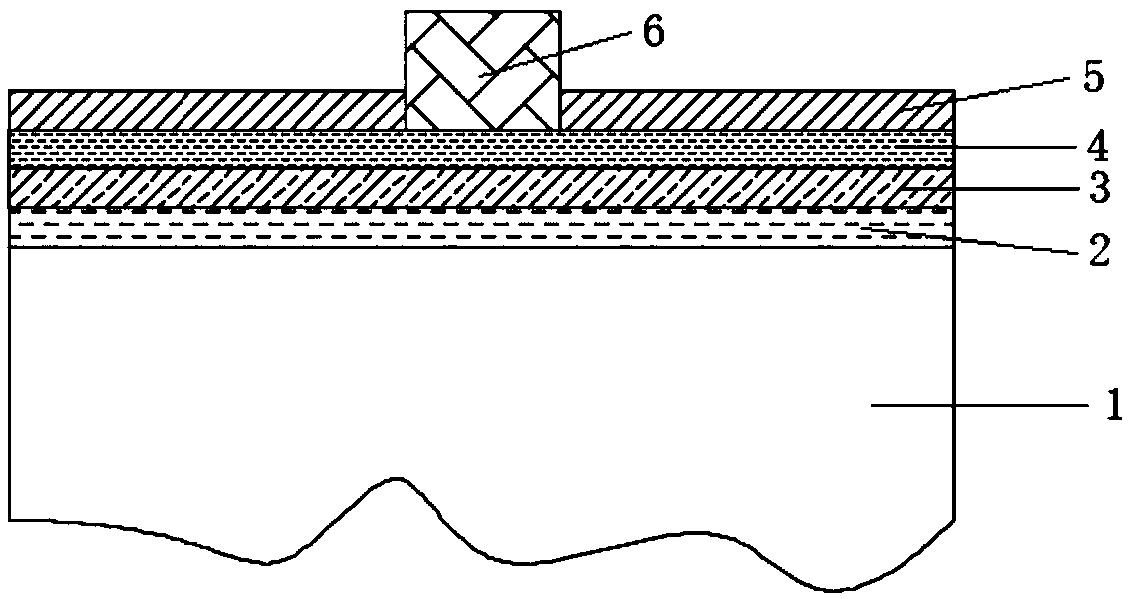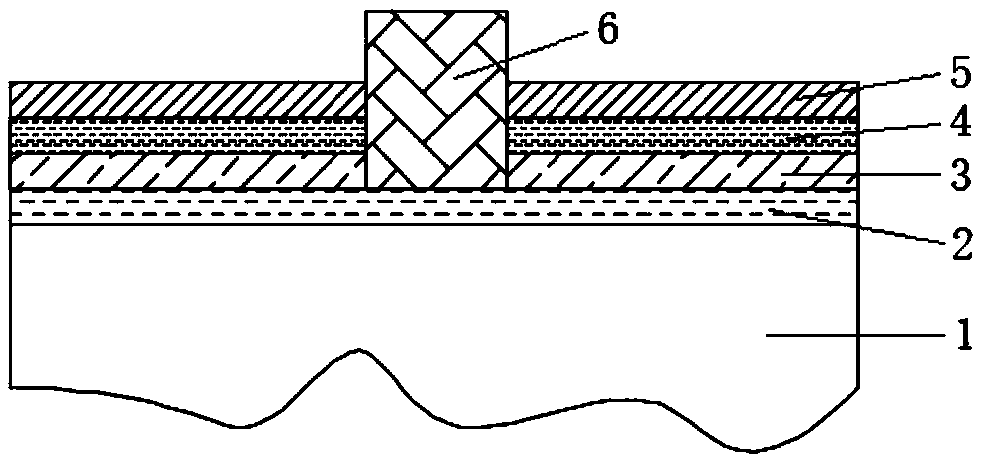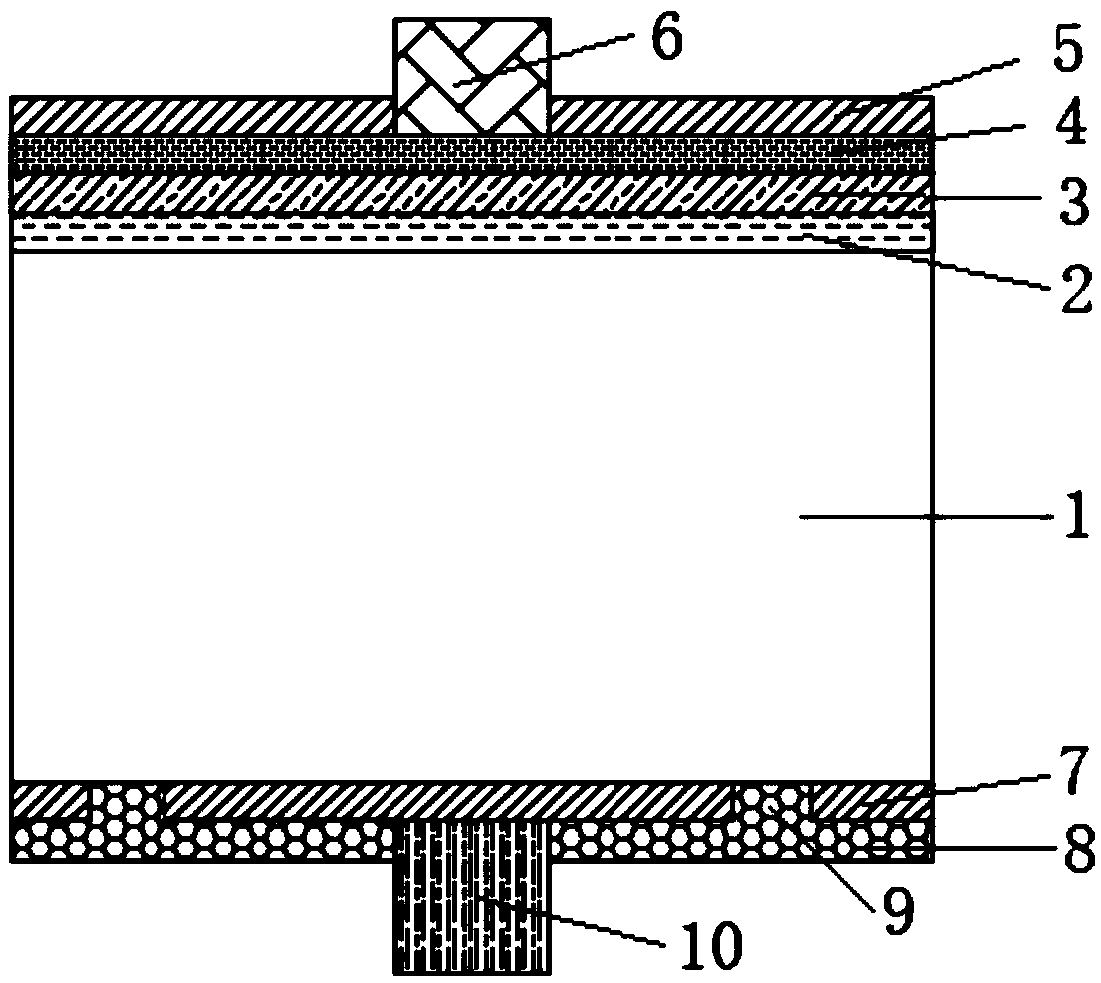Heterogeneous emitting electrode structure of solar cell and solar cell
A solar cell and emitter technology, applied in the field of solar cells, can solve problems such as low cell conversion efficiency, and achieve the effects of improving lateral transmission efficiency, improving surface passivation performance, improving filling factor and conversion efficiency
- Summary
- Abstract
- Description
- Claims
- Application Information
AI Technical Summary
Problems solved by technology
Method used
Image
Examples
Embodiment 1
[0041] Embodiment 1 of the present application provides a heterogeneous emitter structure of a solar cell, and the structural schematic diagram of the heterogeneous emitter structure is as follows figure 1 As shown, it includes: a substrate 1, a first doped layer 2, a passivation tunneling layer 3, a second doped layer 4, a passivation anti-reflection layer 5 and a front electrode 6 (negative electrode thin grid line); the substrate 1, The first doped layer 2 , the passivated tunneling layer 3 , the second doped layer 4 and the passivated anti-reflection layer 5 are arranged in sequence, and the front electrode 6 passes through the passivated anti-reflection layer 5 and contacts the second doped layer 4 .
[0042] Compared with the prior art, the embodiment of the present application adds a passivation tunneling layer 3 to provide better passivation, which can effectively reduce the surface recombination rate and provide a good surface passivation for the battery; at the same t...
Embodiment 2
[0059] Based on the same inventive concept, the embodiment of the present application provides another heterogeneous emitter structure of a solar cell. The structural schematic diagram of the heterogeneous emitter structure is as follows figure 2 As shown, it includes: a substrate 1, a first doped layer 2, a passivation tunneling layer 3, a second doped layer 4, a passivation anti-reflection layer 5 and a front electrode 6; a substrate 1, a first doped layer 2, The passivation tunneling layer 3 , the second doped layer 4 and the passivation anti-reflection layer 5 are arranged in sequence, and the front electrode 6 passes through the passivation anti-reflection layer 5 and is in contact with the second doped layer 4 .
[0060] Compared with the prior art, the embodiment of the present application adds a passivation tunneling layer 3 to provide better passivation, which can effectively reduce the surface recombination rate and provide a good surface passivation for the battery;...
Embodiment 3
[0078] Based on the same inventive concept, an embodiment of the present application provides a solar cell, and the structural schematic diagram of the solar cell is as follows image 3 , Figure 6 and Figure 7 As shown, it includes: a rear passivation film 7, a rear electrode 8, and any heterogeneous emitter structure of a solar cell as provided in the embodiments of the present application.
[0079] The back passivation film 7 is arranged on the side opposite to the first doped layer 2 of the substrate 1 in the heterogeneous emitter structure; the back electrode 8 is arranged on the side opposite to the substrate 1 of the back passivation film 7; the back electrode 8 The contact region 9 through the rear passivation film 7 (a region that penetrates the rear passivation film 7 and can make contact with structures on both sides of the rear passivation film 7 ) is in contact with the substrate 1 .
[0080] Optionally, the solar cell provided in the embodiment of the present ...
PUM
| Property | Measurement | Unit |
|---|---|---|
| Sheet resistance | aaaaa | aaaaa |
| Thickness | aaaaa | aaaaa |
| Thickness | aaaaa | aaaaa |
Abstract
Description
Claims
Application Information
 Login to View More
Login to View More - R&D
- Intellectual Property
- Life Sciences
- Materials
- Tech Scout
- Unparalleled Data Quality
- Higher Quality Content
- 60% Fewer Hallucinations
Browse by: Latest US Patents, China's latest patents, Technical Efficacy Thesaurus, Application Domain, Technology Topic, Popular Technical Reports.
© 2025 PatSnap. All rights reserved.Legal|Privacy policy|Modern Slavery Act Transparency Statement|Sitemap|About US| Contact US: help@patsnap.com



